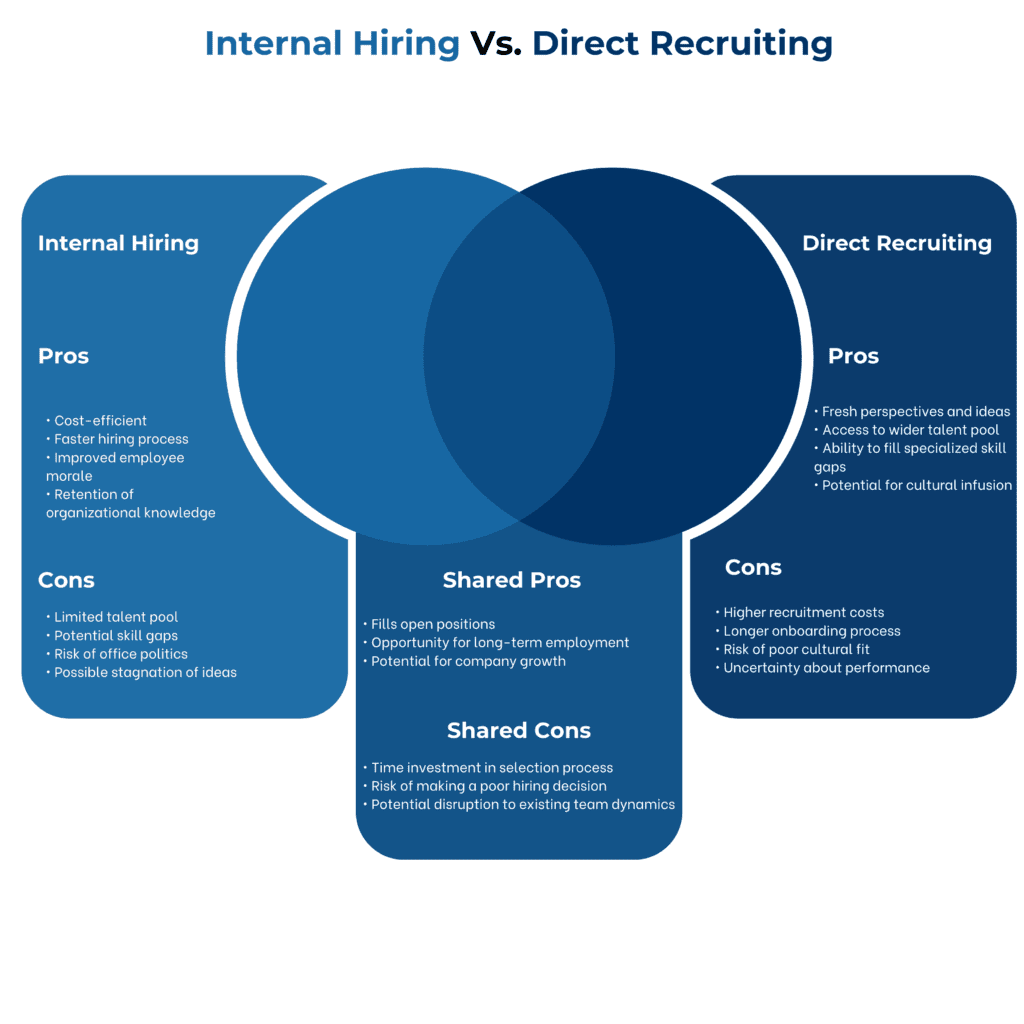Direct Hire Recruiting vs. Internal Hiring: Which Approach is Best?

Hiring the right people is one of the most important decisions any business can make—but should you promote from within or bring in fresh talent from the outside? When it comes to internal hiring versus direct hire recruiting, there’s no one-size-fits-all answer. Both methods have their upsides, but the key is knowing which one (or combination) works best for your company’s unique needs. With the right hiring strategy, you can boost employee morale, reduce turnover, and bring in the specialized skills that keep your business growing.
In this article, we'll break down the pros and cons of both approaches, give you practical tips for making the right choice, and show you how to balance internal promotions with external hiring to build a strong, future-focused team. Whether you're looking to nurture your current talent or inject new ideas into your business, we've got you covered.
What is Direct Hire Recruiting?
Direct hire recruiting is when a company hires someone directly for a permanent, full-time role, often with help from a staffing agency. It’s a straightforward process: posting job ads, screening resumes, interviewing candidates, making job offers, and onboarding new employees. While some companies manage all this in-house, many partner with agencies to make things smoother and access a larger talent pool.
The biggest perk of direct hire? It's permanent. That means the employee becomes a full-time member of the team with benefits like health insurance, PTO, and a retirement plan. It’s especially useful for roles that require specialized skills or leadership experience, where the company needs someone who’s in it for the long haul. Sure, it can take more time and money upfront, but over time, it can pay off with lower turnover, better cultural fit, and a stronger, more loyal team.
What is Internal Hiring?
Internal hiring is all about filling open roles by looking at the talent already within the company. Instead of going external, organizations promote employees, transfer them to different departments, or convert temporary staff into full-time employees. This is a smart way to tap into a workforce that already knows the ropes—no need for long onboarding processes or a ton of training. Plus, it's more cost-effective since there are fewer recruitment and advertising expenses.
Internal hiring offers clear benefits such as saving time, boosting morale, and enhancing employee retention, as it encourages employees to grow within the company and helps maintain company culture. However, it can also lead to office drama due to perceptions of favoritism and may limit diversity if relied upon exclusively. Best practices include balancing internal promotions with external hires, providing training for skill gaps, and ensuring transparency to maintain fairness in the process.
So, while internal hiring is a fantastic way to promote loyalty and tap into existing talent, it's important not to fall into the trap of stagnation or missed opportunities. It's all about finding that balance and keeping things fresh.
Finding the Right Balance

When deciding between direct hire and internal hiring, it really comes down to what the company needs at the moment. Both approaches have clear benefits, but also some trade-offs. Direct hire can bring in fresh perspectives, specialized skills, and a wider pool of talent, which is particularly helpful when a company is expanding or needs expertise that isn't already present. The challenge here is the cost—external recruiting can be expensive, and the onboarding process takes time as new hires need to adjust to the company culture and systems. There's also the risk of hiring someone who may not fully fit into the organization, despite their skills.
On the other hand, internal hiring is quicker and more cost-effective. Employees already know the company culture, which means less training and faster integration. Promoting from within also boosts morale and shows employees that there’s room for growth, helping with retention. However, internal hiring can be limiting in terms of fresh ideas, and employees vying for the same position can create office politics. Additionally, internal candidates might not always have the specialized skills needed for certain roles, which could leave gaps in expertise.
So, what's the best approach? The answer is a balance. Companies should consider their current needs—whether they require fresh talent to drive innovation or want to reward and develop the skills of their existing workforce. For example, a company looking to grow or tackle new projects may benefit from direct hire, while internal hiring is a great way to foster employee loyalty and reduce turnover. By combining both strategies, you can create a dynamic workforce that balances internal talent development with the new ideas and expertise that external hires bring.
Practical tips include clearly defining your hiring goals, understanding the skill gaps within your organization, and keeping your hiring process transparent. Be sure to foster a culture where both internal and external candidates feel valued, and try to avoid over-relying on either method. A strategic combination of both can help you meet your organization's short-term needs while positioning it for long-term success.
Summary
- Direct Hire Recruiting brings in fresh perspectives, specialized skills, and a wider talent pool but can be more costly and time-consuming. It’s a great option for filling critical, high-level roles or when expertise is lacking internally.
- Internal Hiring is cost-effective, faster, and boosts morale by offering growth opportunities to existing employees. However, it can limit diversity and fresh ideas and may not always address skill gaps.
- Balanced Approach: Combining both methods is often the most effective strategy, allowing you to nurture internal talent while bringing in new perspectives and expertise when needed.
Action Items for Readers
- Evaluate your company’s current talent needs—are you looking for specialized skills, or are you focused on employee development and retention?
- Review your internal hiring processes and determine if there are clear pathways for employee growth and promotions.
- If you need to bring in fresh talent, consider whether external recruiting or partnering with a staffing agency is the right choice for your specific role.
- Ensure your hiring strategy aligns with your company's long-term goals and culture, and maintain a balance between internal and external recruitment.
Next Steps
At Integrus Solutions, we specialize in helping businesses navigate the complex world of recruitment, whether you’re focused on direct hire or internal promotions. If you're unsure which approach best fits your needs, or if you want help refining your hiring strategy, our expert team can guide you through the process.
Ready to build your dream team? Contact Integrus Solutions today to learn how we can help you with both internal and external hiring strategies, ensuring you’re set up for success. Visit our website at Integrussolutions.com or reach out to us directly at (832) 483-3101 for more information. Let’s work together to find the right approach for your company’s future!
